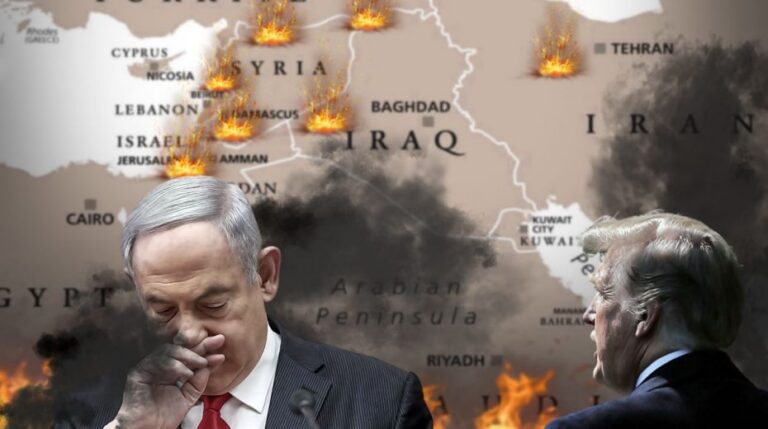
Netanyahu may still label it diplomacy, but to the world it appeared quite differently: a man transformed from a boastful figure claiming control over the American president, to merely that president’s subordinate.
What transpired this past weekend between Donald Trump and Benjamin Netanyahu was as much a vital diplomatic breakthrough aimed at ending Israel’s assault on Palestine, as it was a demonstration of clear power dynamics; a master-servant relationship hidden behind an agreement so striking that even the New York Times felt compelled to portray it as such. Isabel Kershner’s October 5th analysis titled, “Strong-Armed by Trump, Netanyahu Embraces Gaza Deal as a Personal Win – Prime Minister Benjamin Netanyahu of Israel took credit for an emerging agreement, but it was clear that President Trump was calling the shots,” while containing some misleading propaganda, ultimately reveals that Netanyahu’s approach to the war in Gaza has been effectively overridden by Trump.
Gaza cleanup and reconstruction begins as Egypt sends a brigade of bulldozers to begin clearing rubble in Gaza, seen here entering through Rafah – credit video frame shot from Russia Today
Still, there is significant risk that Netanyahu will attempt to rebound and obstruct the peace process through his usual tactics. After all, what is to stop him from resisting what clearly looks like a Trump-led overthrow within the Israeli right against Netanyahu’s policy of ethnically cleansing Palestine’s native population?
Yet, it is now evident that Trump, rather than Netanyahu, set the terms for what seems to be the eventual framework to halt Israel’s offensive in Gaza, secure the release of remaining hostages held by Hamas, and establish a plan for security and rebuilding aligned with the Arab League’s Egyptian proposal from March. This episode sent a clear message to Israelis, Palestinians, and the wider region: Netanyahu no longer holds sovereign authority but is instead compelled to obey his patron.
This shift also reshaped the narrative among much of Trump’s base in the U.S., who, unlike previous neoconservative voters, oppose “forever wars for Israel,” as reported by the Washington Post. American commentators like Tucker Carlson pushed for such a break. Carlson urged Trump to ‘separate’ from Netanyahu, who had publicly proclaimed, “I control the United States, I control Trump.” What a stunning reversal.
Netanyahu’s Saturday statement was a calculated attempt to manage damage. He asserted that the cease-fire deal and hostage release resulted from his prolonged discussions with Trump’s team, implying equal footing in their diplomatic accomplishment. However, this façade quickly dissolved. In an unfiltered interview with Israeli media, Trump asserted control, stating, “He’s got to be fine with it,” referring to Netanyahu. “He has no choice. With me, you got to be fine.” The message was unmistakable: Netanyahu had been coerced, trapped, and stripped of autonomy.
The embarrassment in Israel was tangible. Well-known analyst Nahum Barnea bluntly remarked, “He’s the boss,” identifying Trump as the dominant figure. This phrase encapsulates the new political reality where Trump is no longer Netanyahu’s willing ally but the decisive power steering Israeli policy away from Gaza occupation towards a resolution involving Hamas and Arab nations. Trump’s ultimatum to Hamas and his swift acceptance of their full cooperation underscored that the war’s direction, narrative, and conclusion are now dictated from Washington, by Trump personally. The previously mentioned New York Times article, however, included a misleading disclaimer aligned with Netanyahu’s propaganda, suggesting Hamas had only partially agreed or even disagreed with Trump. This claim is weakly supported and contradicted by Trump’s post on his Truth social account, where he shared Hamas’ letter directly.
By Saturday, Israelis discovered through Trump’s social media, not official announcements, that Israel had consented to an initial Gaza withdrawal as part of the first phase of the deal. This arrangement entailed trading 20 living hostages and the bodies of 28 individuals for 250 Palestinian prisoners serving life sentences plus additional detainees. Trump further declared that once Hamas agreed, a cease-fire would begin “IMMEDIATELY.” Netanyahu’s role was reduced to merely confirming decisions already made by another.
For months, Netanyahu’s political life depended on juggling contradictions: promising his ultra-right coalition a “total victory” over Hamas, deflecting international rebuke over Gaza’s destruction, and attempting to maintain his political survival. Now, his last major influence, Trump, has withdrawn support. Israeli pollster Mitchell Barak, cited in the NYT report, commented:
“It doesn’t look like Hamas is leaving, and it doesn’t look like the total victory he [Netanyahu] promised. I think he realized his credit with Trump ran out. For first time Netanyahu cannot disregard the wishes of an American president, because of the way Trump operates. Trump is unpredictable and will not fall in line with the Israeli position.”
Netanyahu’s traditional defiance toward U.S. presidents, perfected during his conflicts with Obama and Biden (notably Obama), no longer holds. Trump, though seemingly erratic, as predicted by this author, is transactional and unwilling to entertain endless negotiations with stalemates like Netanyahu and Likud. Instead, he uses such engagement to neutralize them. The plan neutralizes the opposition from within.
Trump’s broader strategy extends beyond Netanyahu’s influence in Jerusalem. He is openly balancing Israel’s partnership against relations with Ankara and Doha—both antagonized by Netanyahu. Erdogan’s Turkey, hostile in rhetoric to Israel, and Qatar, accused by Netanyahu of sheltering Hamas leaders, have reentered Trump’s sphere. This repositioning makes Netanyahu’s subservience not only political but existential: he is now the supplicant within a system he once controlled.
Just weeks prior, Netanyahu had expanded military action, directing forces to take Gaza City against the advice of his own generals. This was portrayed as vital to obliterate Hamas. However, facing Trump’s pressure, the attack was abruptly halted. Trump stated on Friday: “Israel must immediately stop the bombing of Gaza, so that we can get the Hostages out safely and quickly!” Within 24 hours, the Israeli military shifted to “defensive operations,” a euphemistic way of standing down. Netanyahu’s doctrine—that Israel would negotiate only during active combat—was undone by a single post from Trump.
Attempting to retain a narrative of control, Netanyahu claimed Israel was “on the verge of a very great achievement.” Yet the maps Trump shared revealed Israel would retreat from crucial Gaza zones, including the Netzarim Corridor recently seized. This military pullback disguised as tactical caution was yet another humiliation for Netanyahu.
Trump holds the phone and forces Netanyahu to apologize to Qatar. Credit – White House
The most visibly humiliating moment came when Trump, asserting dominance, made Netanyahu apologize on a speakerphone to Qatar’s prime minister over a failed Israeli assassination attempt in Doha. The White House circulated a photo of Netanyahu reading from a prepared apology while Trump held the phone grimly beside him. The image was stark: Israel’s longest-serving prime minister appeared less like a leader and more like a subordinate delivering a forced confession.
Trump’s team pushed further by securing Netanyahu’s acquiescence to a cease-fire clause referencing a “credible pathway” to Palestinian statehood—the very outcome Netanyahu has long obstructed. To his far-right Zionist supporters, this is betrayal; to his settler base, capitulation. Yet, he was left with no leverage. Trump had boxed him in, outmaneuvered him, and compelled him to accept a lifetime’s red line.
Israeli commentators find it difficult to grasp this dramatic reversal. Barak, once Netanyahu’s aide, plainly told the NYT that, “His entire career has been in a free fall in the last few days. He agreed to everything.” Nonetheless, others advise caution against premature judgment. Netanyahu’s biographer, Mazal Mualem, noted he has weathered political defeat before. “Bibi knows when to show restraint,” she said. Perhaps he believes accepting Trump’s dominance now will create opportunities to regroup later.
Ultimately, this episode reveals Netanyahu’s reliance openly, a fact long sensed by many in Israel. Trump, the consummate showman, forced the truth into view. By dictating the cease-fire terms, controlling Israel’s military pace, orchestrating Netanyahu’s apology to Qatar, and introducing statehood language into the agreement, he exposed Netanyahu’s claims of control over Trump as fiction. Quite the opposite is true.
This unfolding spectacle imposed multiple humiliations—subjugation, coercion, exposure, and mockery. Netanyahu’s influence was not merely limited; it was displayed as conditional. Trump’s clear message to all—from Tel Aviv to Doha—was that even Israel’s once-untouchable leader now submits to his authority. The psychological impact of this display may outlast the cease-fire itself.
How did Trump achieve this? Much like his initial domestic strategy, Trump repositioned himself within the Republican Party, which he had never fully occupied before. By appealing to right-wing patriots, veterans, and anti-war constituencies from both sides, he undermined neoconservative dominance and shifted much of the party—except a few powerful neocon senators—away from endless wars, Netanyahu’s cult, transatlantic commitments, and hawkish rhetoric towards China. This strategy could not have succeeded outside the GOP or from within the Democrats.
Although the Democrats may resist neoconservatism and transatlanticism, Trump’s approach targeted actual power levers and realistic boundaries informed by realpolitik.
A similar approach unfolded in Israel with “MIGA,” Make Israel Great Again. By casting himself as a staunch pro-Israel Zionist, Trump earned the trust of right-wing factions within Israel’s intelligence, security, and military sectors. These groups increasingly viewed Netanyahu’s tactics as risking Israel’s economic, military, and diplomatic future. Rather than appealing to a liberal minority like Haaretz’s readers or the former Labor base, Trump built alliances with the right-Zionist camp—the segment with the greatest sway over Israel’s political and security decisions.
Prior to Trump, Netanyahu had framed Israel’s future as a choice between Likud’s vision or the dwindling left/progressive opposition. Post-Trump, Netanyahu’s support base is fractured and visibly shaken.
Trump confirmed his role as a more dependable “MIGA” within Israeli politics during the joint press conference with Netanyahu, following the forced signing of the Gaza peace deal—a pact in which Netanyahu conceded on nearly all his significant aims. At the adjacent podium, Trump explained, looking directly at Netanyahu:
“They have large crowds gathering in Israel all the time and they have my name up. They like me for whatever reason, Bibi. I don’t know. But they do like me. But uh they say two things: ‘Please get the hostages back and please end the war’. They’ve had it.”
Netanyahu may continue calling it diplomacy, but observers worldwide witnessed a once-arrogant braggart boasting control over the American president reduced to his assistant—from commander to captive driven by dependency. For Trump, this was the true victory—beyond the initial step toward ending the genocidal conflict against Palestinian civilians, it was proof of who ultimately wields power.
Follow Joaquin on Telegram @NewResistance or on X/Twitter @XoaquinFlores






